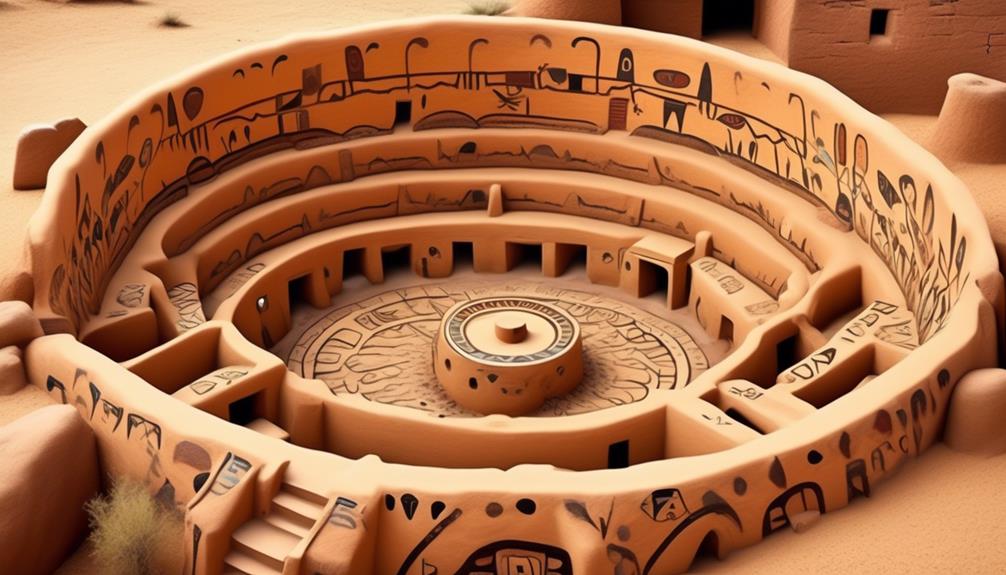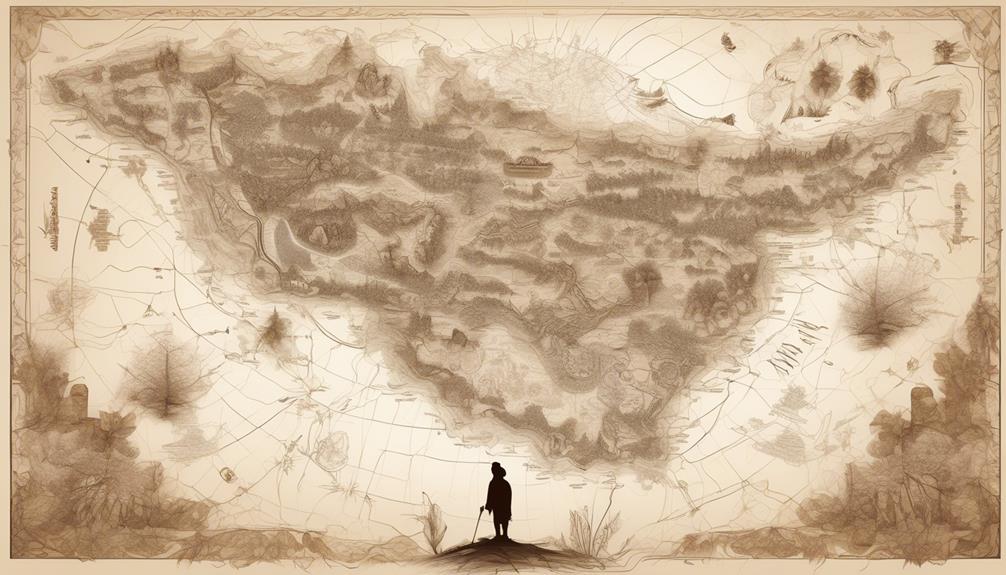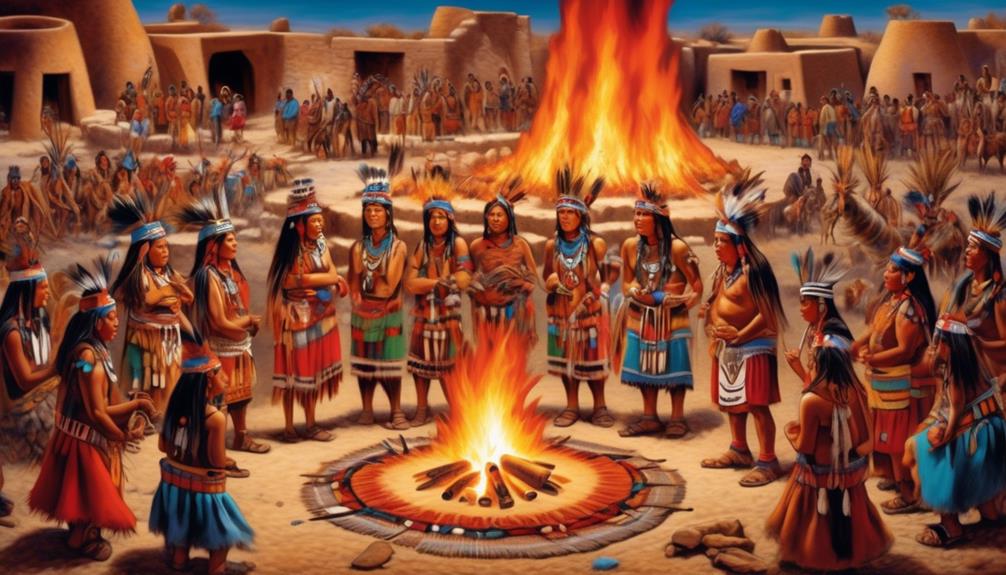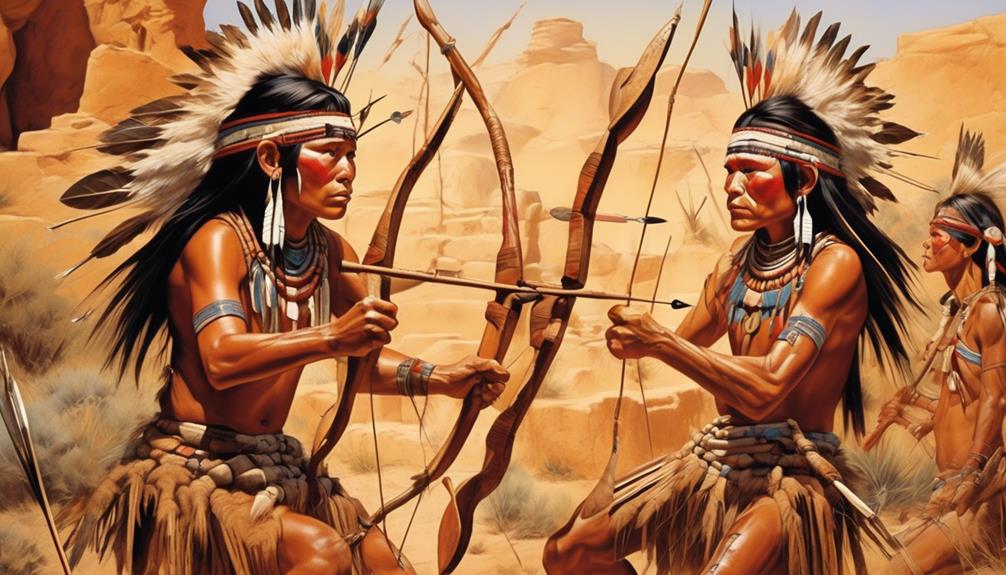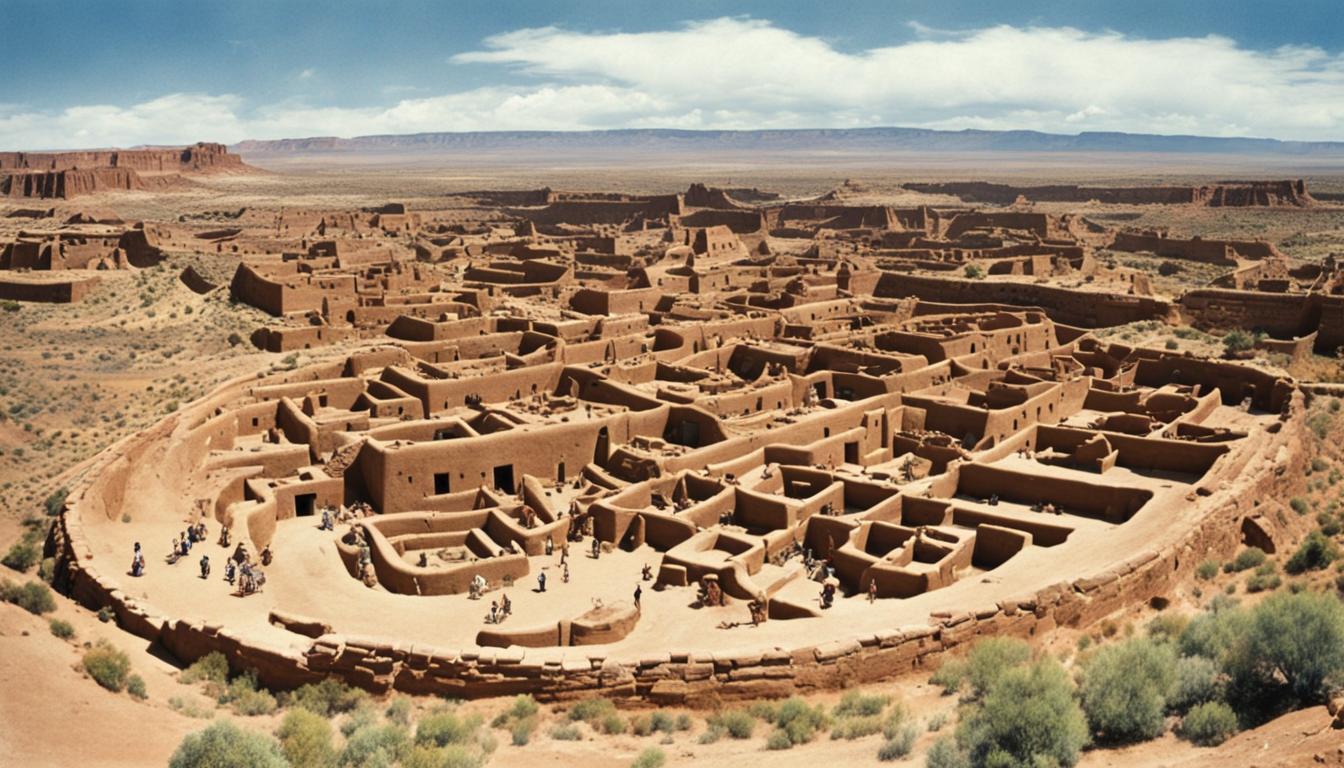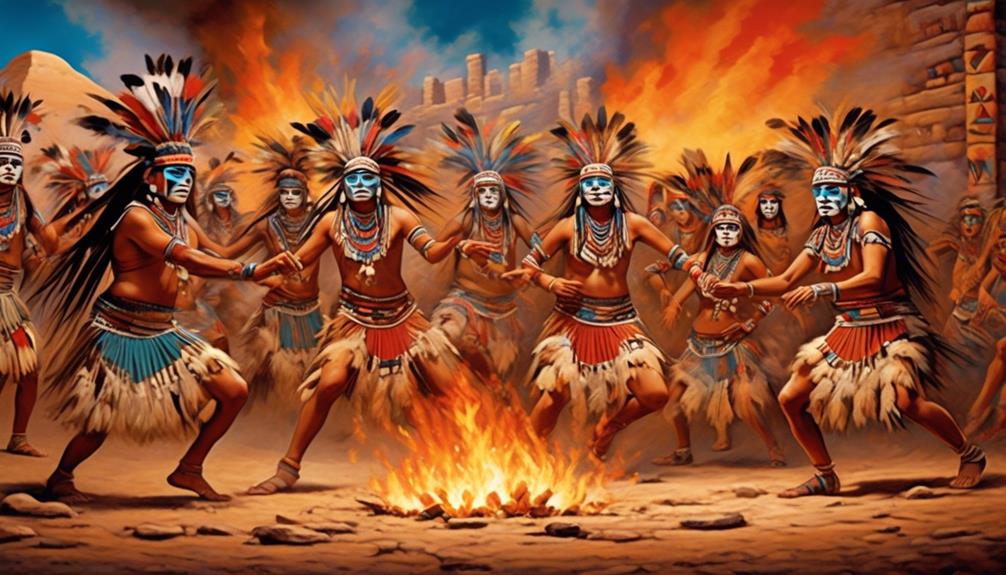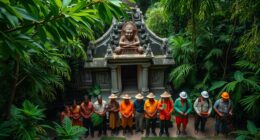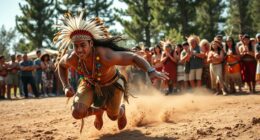According to tradition, the Hopi people believe in the concept of “it takes a village”, which is reflected in the intricate web of clans that form the foundation of their tribal heritage.
As we explore the rich tapestry of Hopi culture, one question lingers in the air: just how many clans make up this ancient and resilient tribe?
The answer to this query unveils not only a numerical count but also a deeper understanding of the Hopi people's interconnectedness and the enduring significance of their clan system.
Key Takeaways
- Hopi clans have a long history dating back to ancient times and their migration patterns shape the clan system.
- Clans play a significant role in shaping the social fabric of Hopi society, contributing to the transmission of traditional knowledge and serving as a support system.
- Each clan is associated with specific totems, colors, and symbols, determining relationships, roles, and responsibilities within the community.
- The preservation of clans faces challenges from external cultural forces and the integration of modern lifestyles, but efforts such as cultural education programs and revitalization of traditional ceremonies aim to ensure the continuity and vitality of Hopi clans for future generations.
Origin and History of Hopi Clans
The origin and history of Hopi clans date back to ancient times, shaping the cultural identity and social structure of the Hopi people. The origins of the Hopi clans are rooted in the migration patterns of the Hopi ancestors, who journeyed across the Southwest, eventually settling in the region known as the Four Corners. This migration played a crucial role in the development of the clan system, as each clan has its own migration story, traditions, and responsibilities within the community.
The migration patterns of the Hopi people are intricately woven into the fabric of their clan system, influencing their relationships with the land and their interactions with other clans. Each clan traces its lineage back to specific geographical locations and migratory routes, which are passed down through oral tradition and ceremonies. These migration patterns not only connect the Hopi people to their ancestral homelands but also serve as a living testament to their enduring cultural heritage.
Understanding the origins and migration patterns of the Hopi clans provides insight into the deep-rooted connections between the Hopi people, their land, and their cultural traditions.
The Role of Clans in Hopi Society
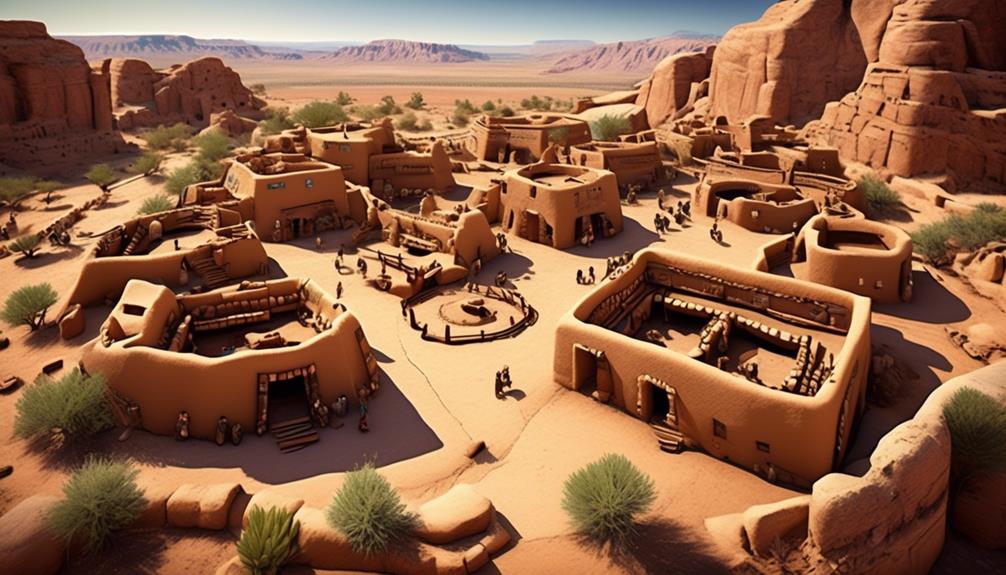
Rooted in the historical migration patterns of the Hopi ancestors, the clans play an integral role in shaping the intricate social fabric of Hopi society. The role of kinship within the clans fosters a sense of belonging and interconnectedness, forming the foundation of community structure. Kinship ties are central to the organization of Hopi society, influencing social, religious, and political aspects of daily life. Clans aren't just a means of tracing lineage; they're essential for the well-being of the community, serving as a support system and a source of cultural continuity.
The clans also play a vital role in the transmission of traditional knowledge and practices. Through kinship networks, valuable cultural teachings, ceremonies, and oral histories are passed down from generation to generation. This preservation of heritage contributes to the cohesion and resilience of the community, ensuring that the rich tapestry of Hopi traditions endures.
Moreover, the clans contribute to the governance of the Hopi tribe. Each clan has its own leaders and representatives who play significant roles in decision-making processes and the maintenance of social order. By upholding the role of kinship and community structure, the clans continue to be indispensable to the vitality and harmony of Hopi society.
Traditional Clans and Their Significance
In Hopi society, traditional clans hold significant importance in shaping community structure and preserving cultural heritage. The clans aren't just familial groups, but they're deeply intertwined with the spiritual and ceremonial aspects of Hopi life. Here are some key points about the significance of traditional clans:
- *Significance*: Clans are the building blocks of Hopi society, providing the framework for social organization and interaction.
- *Symbolism*: Each clan is associated with specific totems, colors, and symbols that carry deep spiritual and cultural meanings.
- *Kinship*: Clans form the basis of kinship systems, determining relationships, roles, and responsibilities within the community.
- *Inheritance*: Through clans, knowledge, traditions, and ceremonial practices are passed down from one generation to the next, ensuring the continuity of Hopi cultural heritage.
- *Community Cohesion*: The clans foster a sense of belonging, solidarity, and mutual support, strengthening the fabric of the community.
Understanding the significance of traditional clans is essential for appreciating the rich tapestry of Hopi culture and the interconnectedness of its members.
Modern Challenges and Preservation of Clans

Despite the enduring significance of traditional clans in Hopi society, modern challenges have emerged that threaten their preservation and continuity. In recent times, the Hopi Tribe has been facing contemporary issues that directly impact the preservation of its clans. One major challenge is the influence of external cultural forces, which can erode the traditional practices and knowledge associated with the clans. Additionally, the increasing integration of modern lifestyles and technologies has led to a gradual dilution of the younger generation's connection to their clan heritage. Efforts to address these contemporary issues and preserve the clans have been ongoing within the Hopi Tribe. Various preservation efforts include cultural education programs in schools, intergenerational knowledge sharing initiatives, and the revitalization of traditional ceremonies and practices. These endeavors aim to instill a sense of pride and belonging among the younger Hopi members, fostering a deeper appreciation for their clan heritage. By actively addressing these challenges and implementing preservation strategies, the Hopi Tribe endeavors to ensure the continuity and vitality of its clans for future generations.
| Preservation Efforts | Contemporary Issues | Cultural Education Programs |
|---|---|---|
| Intergenerational Knowledge Sharing | External Cultural Influences | Revitalization of Traditional Ceremonies |
| Pride and Belonging Initiatives | Integration of Modern Lifestyles | Heritage Appreciation Initiatives |
Counting the Clans: How Many Are There?
While the exact number of clans within the Hopi Tribe may vary, the significance of each clan's role in the community remains paramount. Counting the clans is a complex task due to various factors such as migration, intermarriage, and the oral tradition of passing down clan knowledge. Here are some methods used to count the clans and their cultural significance:
- Oral Histories: The Hopi people traditionally rely on oral histories to recount the lineage of clans. Elders play a crucial role in preserving and passing down this valuable knowledge.
- Ceremonial Records: Certain ceremonies and rituals within the Hopi Tribe involve specific clan affiliations, offering insights into the existing clans and their roles in the community.
- Genealogical Research: Modern methods of genealogical research, such as DNA testing and historical records, are increasingly being used to trace clan lineages and identify the number of existing clans.
- Community Consultation: Engaging the community in discussions and consultations allows for the collective knowledge of the clans to be shared and documented.
- Anthropological Studies: Academic research and anthropological studies provide valuable insights into the history and development of Hopi clans, contributing to the understanding of their cultural significance.
These methods collectively contribute to the understanding of the intricate network of Hopi clans and their enduring cultural importance.
Frequently Asked Questions
How Are Hopi Clan Members Chosen or Assigned to Specific Clans?
In the Hopi clan structure, clan membership assignment is typically based on the mother's clan. Children are born into their mother's clan and carry on her lineage.
This system is integral to the Hopi cultural and social identity, as it determines an individual's roles and responsibilities within the community.
Hopi clan members are chosen through this matrilineal lineage, which plays a significant role in shaping the cultural traditions and practices of the tribe.
Are There Any Rituals or Ceremonies That Are Specific to Individual Hopi Clans?
In our Hopi culture, ceremonial practices and rituals hold significant importance, especially within individual clans. These rituals are specific to each clan and play a vital role in maintaining our cultural identity and spiritual beliefs.
Each clan has unique ceremonies that are passed down through generations, serving as a way to honor our ancestors and connect with our heritage. The ritual significance of these ceremonies strengthens the bonds within our clans and reinforces our shared values.
What Are the Criteria for Someone to Be Considered a Member of a Hopi Clan?
To be considered a member of a Hopi clan, certain criteria must be met. Clan membership and inheritance are central, passed through the mother's line.
Participation in clan rituals and ceremonies strengthens these ties. It's a deeply meaningful connection, shaping our identity and responsibilities within the community.
These traditions are valued and preserved, ensuring the continuity of our cultural heritage.
How Do Modern Hopi Clans Adapt to Changes in Traditional Practices and Societal Dynamics?
In adapting to modern changes, Hopi clans balance cultural preservation and modern adaptation. We uphold generational continuity while embracing societal evolution.
Our clans honor traditional practices while also finding ways to integrate them into our daily lives. This delicate balance allows us to maintain our heritage while navigating the complexities of the modern world.
We respect the wisdom of our ancestors while also embracing the opportunities and challenges of the present.
Are There Any Efforts to Revitalize or Preserve Lesser-Known or Endangered Hopi Clans?
Efforts to preserve and revitalize lesser-known or endangered Hopi clans are crucial for maintaining our cultural heritage.
Through community initiatives and educational programs, we're working to ensure that these clans are celebrated and their traditions are passed down to future generations.
It's a meaningful way to honor our ancestors and keep our cultural identity strong.
Conclusion
In conclusion, the Hopi tribe is a rich and diverse community with a deep connection to their traditional clans. As the saying goes, 'it takes a village to raise a child,' and in the case of the Hopi, it takes a clan to uphold their cultural heritage.
With ongoing challenges, the preservation of these clans is crucial for the future of the tribe. It's important to continue to honor and respect the significance of each clan within the Hopi society.
Mary is a passionate writer who brings creativity and a fresh perspective to our team. Her words have the power to captivate and inspire, making her an essential contributor to our content. Mary’s commitment to storytelling and dedication to promoting Indigenous culture ensures that her work touches the hearts of our readers. We’re fortunate to have her as part of our team.
